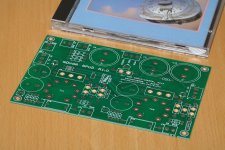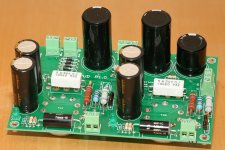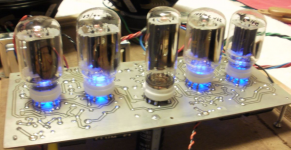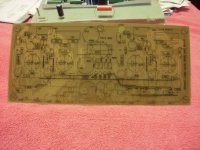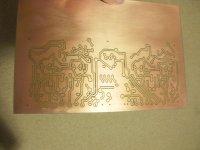Another quick question Tom: the tube sockets from ESRC, is the correct part number SK-9c? That appears to be a chassis mount socket? Thanks, Pete.
I'm in, sent the funds to you via paypal earlier today.
Saw the money trickle in. You should have an email. Thanks for your order.
I'm wondering if there's any chance you can send me a copy of the BOM?
I'm working on getting that together. I expect it to be done by the time the boards show up. I'll see if I can get it to you earlier. The parts are nothing special. I'm sure you can find them locally as well.
I'll probably go with the James and Antek transformers as per your recommendation. One question: do the James OPT have UL taps? I don't see it mentioned in the specs.
It doesn't look like it. I've never seen a James OPT in person, but looking at the image on their website, I doubt the transformer has UL taps. It would be rather hard to do with the multiple primary taps, I imagine. But with 3.5 kΩ and 5 kΩ taps on the primary, you should have plenty of options. 3.5 kΩ should give you more power, but also slightly higher THD.
I've seen several builds on DIY Audio that used the James OPTs. They look like they're pretty good bang for the buck.
Thankyou for making this project avaliable to less experienced DIY'ers such as myself.
You're welcome.
Another quick question Tom: the tube sockets from ESRC, is the correct part number SK-9c?
Last I checked, I didn't see the socket on ESRC's website. I found them on ESRC's eBay page and emailed Stan (at ESRC) directly. He hooked me up with the correct sockets. I suggest tossing ESRC an email and make sure you get the right sockets. You want sockets for 9-pin Novar tubes (6GF7A, 6LR8) for PCB mounting.
~Tom
Thanks Tom for your reply. Do you think, with the James OPT's wired to 5k, would it be possible to use the 3.5k primary tap as the UL connection? I'm probably way off track?.. 30% UL? They do look like good bang for the buck. Best redards, Pete.
Do you think, with the James OPT's wired to 5k, would it be possible to use the 3.5k primary tap as the UL connection? I'm probably way off track?.. 30% UL? They do look like good bang for the buck. Best redards, Pete.
I highly doubt that you can use the 3.5k tap as an UL tap on the 5k winding and get good results. You certainly won't get the 40 % UL tap, but as I recall, that's just the optimal point as far as power vs distortion goes. There's nothing magical about it. So I guess you can try, but keep your expectations low. 🙂
If you want to use the UL configuration, get a transformer with a UL tap. The Edcor CXSE25-series is incredibly bang for the buck. The only drawback is the lead time (6-8 weeks typically).
For Triode mode, the James transformers look like incredible bang for the buck. And they're in stock...
~Tom
Don't know if this helps:
.subckt 6LU8 1 2 3
+Params: MU=58 KP=800 KVB=4500 EX=1.23 KG1=430
E1 7 0 Value = {(V(1,3)/KP)*LN((1+ EXP((KP/MU) + ((KP*(V(2,3)))/(SQRT(KVB+V(1,3)*V(1,3)))))))}
RE1 7 0 1e12
G1 1 3 VALUE = {(((V(7))^EX)/KG1)*(1+SGN(V(7)))}
RCP 1 3 1e12
C1 2 3 7e-12
C2 1 2 6e-12
C3 1 3 2e-12
R1 2 5 2000
D3 5 3 dx
.model dx d(is=1e-09 rs=1 cjo=10e-12)
.ends
.subckt 6LU8_Pent 1 2 3 4
+Params: MU=7.81 KP=27.3 KVB=21.4 EX=1.49 KG1=752
E1 7 0 Value = {(V(2,4)/KP)*LN((1+ EXP((KP/MU) + ((KP*(V(3,4)))/(V(2,4))))))}
RE1 7 0 1e12
G1 1 4 VALUE = {(((V(7))^EX)/KG1)*(1+SGN(V(7)))*(ATAN(V(1,4)/KVB))}
RCP 1 4 1e12
C1 3 4 16e-12
C2 1 3 0.5e-12
C3 1 4 9.0e-12
R1 3 5 1000
D3 5 4 dx
.model dx d(is=1e-09 rs=1 cjo=10e-12)
.ends
.subckt 6LU8 1 2 3
+Params: MU=58 KP=800 KVB=4500 EX=1.23 KG1=430
E1 7 0 Value = {(V(1,3)/KP)*LN((1+ EXP((KP/MU) + ((KP*(V(2,3)))/(SQRT(KVB+V(1,3)*V(1,3)))))))}
RE1 7 0 1e12
G1 1 3 VALUE = {(((V(7))^EX)/KG1)*(1+SGN(V(7)))}
RCP 1 3 1e12
C1 2 3 7e-12
C2 1 2 6e-12
C3 1 3 2e-12
R1 2 5 2000
D3 5 3 dx
.model dx d(is=1e-09 rs=1 cjo=10e-12)
.ends
.subckt 6LU8_Pent 1 2 3 4
+Params: MU=7.81 KP=27.3 KVB=21.4 EX=1.49 KG1=752
E1 7 0 Value = {(V(2,4)/KP)*LN((1+ EXP((KP/MU) + ((KP*(V(3,4)))/(V(2,4))))))}
RE1 7 0 1e12
G1 1 4 VALUE = {(((V(7))^EX)/KG1)*(1+SGN(V(7)))*(ATAN(V(1,4)/KVB))}
RCP 1 4 1e12
C1 3 4 16e-12
C2 1 3 0.5e-12
C3 1 4 9.0e-12
R1 3 5 1000
D3 5 4 dx
.model dx d(is=1e-09 rs=1 cjo=10e-12)
.ends
The models look like output from Norman Koren's MATLAB scripts to me.
Which Excel curve fitter are you referring to? Would you post a link?
Thanks,
~Tom
Which Excel curve fitter are you referring to? Would you post a link?
Thanks,
~Tom
Hi Tom & everyone. The board looks great in the photo above, nice and compact. I'm keeping my eyes peeled for some kind of funky enclosure to mount all the parts into. With a very active 2 year old in the house it's going to need to be fully enclosed or at least have a cage over the tubes.
So an update on all the parts. The board is on it's way "downunder". (thx!) Antek transformer and Triad choke are ordered. 6LR8 tubes and pcb sockets from ESRC ordered. Stan was great to deal with, replied to email in like 10 minutes! My *awesome* missus has ordered the James OPT's for my birthday present! Digikey order is also done (it's just easier, last order from th local supplier wasn't good..) Already have IEC power inlet with fuse and switch. Likewise RCA jacks and speaker posts.
One part number didn't work for me at digikey, solen PPE 220. I'll try to find an Aussie supplier for those.
So I'm getting just a bit excited and really looking forward to getting started.
Any chance mine could be the first one working in the southern hemisphere?
Best regards, Pete.
So an update on all the parts. The board is on it's way "downunder". (thx!) Antek transformer and Triad choke are ordered. 6LR8 tubes and pcb sockets from ESRC ordered. Stan was great to deal with, replied to email in like 10 minutes! My *awesome* missus has ordered the James OPT's for my birthday present! Digikey order is also done (it's just easier, last order from th local supplier wasn't good..) Already have IEC power inlet with fuse and switch. Likewise RCA jacks and speaker posts.
One part number didn't work for me at digikey, solen PPE 220. I'll try to find an Aussie supplier for those.
So I'm getting just a bit excited and really looking forward to getting started.
Any chance mine could be the first one working in the southern hemisphere?
Best regards, Pete.
I get the Solen caps from Antique Electronic Supply. You can use Panasonic ECQ-E6224KF (Digikey EF6224-ND) instead. I put both on the BOM.
You'll notice that the footprint for the coupling cap has two parts to it. C1A and C1B. The two footprints overlap so you either stuff one or the other. One footprint fits the Solen cap (and other higher end caps). The smaller footprint fits the Panasonic caps.
~Tom
You'll notice that the footprint for the coupling cap has two parts to it. C1A and C1B. The two footprints overlap so you either stuff one or the other. One footprint fits the Solen cap (and other higher end caps). The smaller footprint fits the Panasonic caps.
~Tom
Just becuz you found it, doesn't mean i can 't post it -- the UTracer only goees to 200mA:
An externally hosted image should be here but it was not working when we last tested it.
Just becuz you found it, doesn't mean i can 't post it...
Awesome! thanks, in any case, I think there is something wrong with plots from the above linked site, the pentode curves do not match up with the datasheet (weak tubes or measurement error, I am not sure).
Maybe they didn't allow enough time for warm-up. I find the operating point requires at least 15 minutes to settle to its final value. Of course, that could be caused by the tube but also by the temperature coefficient of cathode resistors and such.
~Tom
~Tom
Thanks!
I went back to resistive bias with partial decoupling (as shown in my original schematic). The 6LR8 in triode really rocks. I'm rather blown back. I get about 0.3 % THD+N @ 1 kHz, 1 W and 4.6~4.7 W @ 1 kHz, 3 % THD+N.
It sounds very good with the LED biasing, but the performance is better with the partially decoupled resistive bias.
Unless you want the bragging rights of getting 6 W out or prefer pentode sound, triode mode is where it's at!
~Tom
I went back to resistive bias with partial decoupling (as shown in my original schematic). The 6LR8 in triode really rocks. I'm rather blown back. I get about 0.3 % THD+N @ 1 kHz, 1 W and 4.6~4.7 W @ 1 kHz, 3 % THD+N.
It sounds very good with the LED biasing, but the performance is better with the partially decoupled resistive bias.
Unless you want the bragging rights of getting 6 W out or prefer pentode sound, triode mode is where it's at!
~Tom
They make a very respectable PP amp. I did a toner transfer PCB design for a quick build. Sounds awesome with Bogen MX30A output iron. 6.6KRaa.
It was a universal PCB, allowed for Fixed or cathode bias, I chose fixed. Also allowed for Triode, Pentode or Ultra Linear configuration. I chose Pentode for the first amp.
It was a universal PCB, allowed for Fixed or cathode bias, I chose fixed. Also allowed for Triode, Pentode or Ultra Linear configuration. I chose Pentode for the first amp.
Attachments
Last edited:
I used toner transfer for my prototypes as well. Works great as long as you keep the trace/space rules reasonable. For tube circuits that's rarely an issue.
I'm impressed with these sweep tubes. The 6GF7A is very nice as well. Not quite enough power for my taste, but I bet it would make a really sweet headphone amp.
~Tom
I'm impressed with these sweep tubes. The 6GF7A is very nice as well. Not quite enough power for my taste, but I bet it would make a really sweet headphone amp.
~Tom
- Home
- Vendor's Bazaar
- Novar Spud :: A $200 sweep tube Spud with PCB
